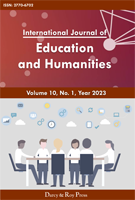Study of Male Characters in Wilde’s The Picture of Dorian Gray Based on Horney’s Conflict Theory
DOI:
https://doi.org/10.54097/ijeh.v8i3.8701Keywords:
The Picture of Dorian Gray, Wilde, Horney, conflicts, attempts at solution.Abstract
In the late Victorian era, due to the bourgeoisie’s profit-oriented material supremacy and the collapse of traditional religious value system, Wilde advocates aestheticism in order to find the meaning of life. At the same time, Wilde advocates a new hedonism in order to fit in with the crowd, expecting the world to liberate itself and to find the enjoyment of beauty. But in the process, Wilde’s heart is torn between two sides and his interpersonal relationships are disrupted. In The Picture of Dorian Gray, he creates three characters associated with him. And these three characters are also endowed with Wilde’s conflict. They make all kinds of attempts to resolve the conflict of inner opposition. By analyzing the inner conflicts of the three characters and their interpersonal relationships based on Horney’s conflict theory, this paper discusses the complexity of Wilde’s inner heart as well.
Downloads
References
Baldwin, S. P. (2000). The Picture of Dorian Gray notes. University of Kentucky.
Horney, K. D. (1939). New ways in psychoanalysis. Routledge and Kegan Paul Ltd, 5-40
Horney, K. D. (1999). Our inner conflicts. Routledge and Kegan Paul Ltd, 1-107.
Lian, Y. P. & Zhong, J. D. (2021). Oscar Wilde’s multiple appeals revealed in the male characters in The Picture of Dorian Gray, 11(2): 1-7.
Mason, S. (1908). Oscar Wilde: Art and morality, 10-12.
Wilde, O. (1969). The Critic as artist: Critical writings of Oscar Wilde. Random House, 10-47.
Wilde, O. (2010). The Picture of Dorian Gray. Shanghai Foreign Language Education Press, 6.
Wilde, O. (2018). The Picture of Dorian Gray. Liaoning People’s Publishing House, 1-248.
Yang, N. (2017). A Study of Oscar Wilde’s “mask art”. Chinese Social Sciences Press, 148.


















